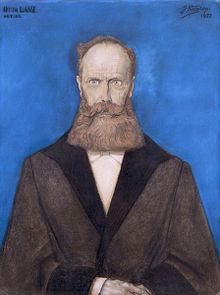Otto Lanz

Otto Lanz (born October 14, 1865 in Steffisburg , † March 23, 1935 in Amsterdam ) was a Swiss surgeon .
After studying medicine in Geneva, Basel, Bern, Leipzig and Munich, Lanz became an assistant to Ludwig Lichtheim in 1888 , and from 1890 he was assistant to Emil Theodor Kocher's surgical university clinic in Bern. In 1891 he received his doctorate from the University of Bern . In the years 1892/93 he visited Berlin, Naples and London. In 1893 he completed his habilitation in Bern and became a private lecturer in surgery. In 1897 he opened a private practice in the newly built Lindenhof Hospital in the back Länggasse . In 1902 he was appointed professor to Amsterdam, where he worked until his death. Otto Lanz is known for his publications on thyroid surgery, the mesh graft technique (which he developed in 1907) and appendicitis (he described the Lanz point named after him ).
Otto Lanz was a passionate collector of Italian Renaissance art. He left several paintings, sculptures and ceramics to the Rijksmuseum and the Stedelijk Museum in Amsterdam. In 1941 the collection was bought by the Nazis for Hitler's “Führermuseum” in Linz , but it came back to the Netherlands after the war. Part of the collection is on display in the Bonnefantenmuseum in Maastricht until 2011 .
Fonts
- On the thyroid question. Collection of clinical lectures. Leipzig 1894.
- Contributions to the thyroid issue. In: Mitt. Klin. And. med. Inst. D. Switzerland. Basel and Leipzig 1895.
- Het streven naar volmaakte asepsis. Geneeskundige bladen uit kliniek en laboratorium voor de pragijk, Haarlem 1904.
- Concerning the transplant. In: Zentralblatt für Chirurgie. Leipzig 1908, Vol. 35 (1), pp. 1-32.
- McBurney's point. In: Zentralblatt für Chirurgie. Leipzig 1908, Vol. 35, pp. 185-190.
Web links
- Literature by and about Otto Lanz in the catalog of the German National Library
- Otto Lanz at www.whonamedit.com
- Urs Boschung: Lanz, Otto. In: Historical Lexicon of Switzerland .
- Photos by Otto Lanz
Individual evidence
- ↑ see also article about the forced sale of the picture collection in the Dutch Wikipedia nl: Collectie Lanz and the overview article looted art (Second World War)
- ↑ at DNB there is no clear demarcation from Otto Lanz (Förster)
| personal data | |
|---|---|
| SURNAME | Lanz, Otto |
| BRIEF DESCRIPTION | Swiss surgeon |
| DATE OF BIRTH | October 14, 1865 |
| PLACE OF BIRTH | Steffisburg , Switzerland |
| DATE OF DEATH | March 23, 1935 |
| Place of death | Amsterdam |